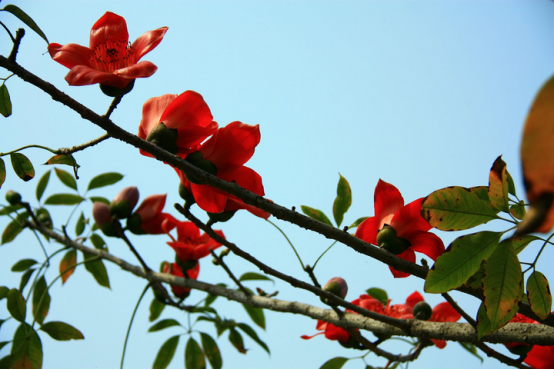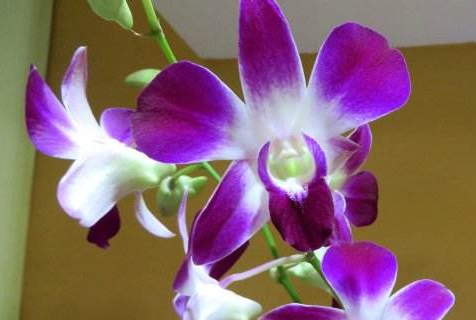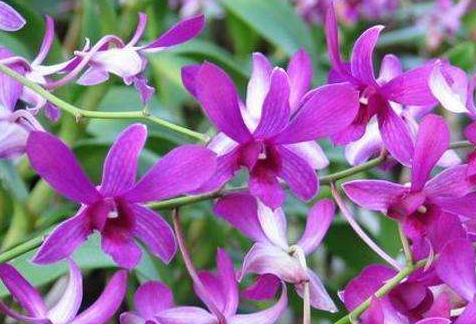three。 Culture methods of kapok
1. Seed collection and treatment
The kapok fruit is grayish black when it is ripe, and the seeds of the flowers can easily float around with the cotton wool, so if you want to collect the seeds in time, spread out and expose the seeds after harvest. A thousand seeds weigh about 47.5 grams and the germination rate is between 70% and 80%. If stored for too long, the germination rate will decrease or even lose the ability of germination. Therefore, it is best to sow on demand, if you want to delay, you can use wet sand for short-term storage.
Disinfect the seeds with 0.3% potassium permanganate solution before sowing, then rinse with clean water, dry and sow the seeds.

two。 Soil preparation and sowing
The slightly acidic loam with good drainage, deep layer, loose soil, good structure, sufficient light and strong water retention was selected as the sowing ground. It is best to prepare the soil carefully before sowing. Sowing is used to sow. After sowing, the soil is 2 cm thick. After a little suppression, the seeds are closely combined with the soil, then drenched with enough water, and then drenched with water for 1 to 39 times a day to keep the soil moist.
3. Seedling management
Generally, the seeds of kapok begin to germinate 4 days after sowing, and the germination is basically completed within 3 days. After the seedlings are unearthed, the soil should be kept moist to meet the moisture requirements in the growth process of kapok. When the sun is strong and the temperature is high, shading nets can be used to prevent high temperature and sunburn.
Detailed explanation of culture methods of kapok
Kapok, also known as Panzhihua, kapok and hero tree, comes from the dried flowers of kapok, a plant of kapok family. Kapok is tall, majestic and burly, its branches are stretched, its red flowers are as big as a cup, and the leaves almost fall when it is in full bloom. From a distance, it looks like a fire burning and jumping happily on the branches, very imposing. Therefore, it has always been regarded as a symbol of heroes. In the green mountains, it is like a beacon burning. It is the "indicator plant" of the climate. As a local saying goes, "Red cotton blooms and spring warms up." In Dai love songs, young girls often boast their beloved young man as a tall kapok tree. Kapok is a beautiful ornamental flower. It blossoms with long leaves in spring. The flowers are red and beautiful. The gorgeous flowers dyed half of the sky red. Liu Kezhuang, a poet of the Song Dynasty, wrote a poem: "A few trees are red for half a day, and people say they are kapok." The kapok song by Chen Gongyin in the Qing Dynasty: "on the day of February and March in Yuejiang, thousands of trees blossomed. It is like Yao shooting out of the sea on the 10th, more like the high platform of the ten thousand torch rings in the Wei Palace. " Describe the beauty of kapok blooming. Kapok is mostly distributed in Guangdong, Guangxi, Fujian, Taiwan and other southern provinces, wild, can also be cultivated, like dry heat, high temperature resistance, growing in tropical and subtropical jungles and river valleys. Since ancient times, the Dai people in Xishuangbanna have made ingenious and full use of kapok: Dai tapestry has been mentioned many times in ancient Chinese books, which is based on the fruit catkins of kapok, known as "Tongjin", which is famous in the Central Plains; the inflorescence or fiber of kapok is used as the filling material for pillows and mattresses, which is very soft and comfortable; dishes cooked with kapok petals also appear from time to time on the dinner table; the flowers, skins and roots of kapok all have medicinal value. Kapok has the effect of clearing heat and diuresis, detoxification and hemostasis.
Cultivation method
Kapok trees like high temperature and drying, have strong early tolerance, and the land with fertile soil is the most suitable for planting. Its reproduction method is mainly seed and cutting method, spring and autumn rainy season is a good season for sowing, growing up as long as a little fertilization. Because the kapok tree is tall, it is most suitable to be used as a street tree. If you want to plant in pots, you can sow and raise seedlings from the seedlings. The cultivation site must be sunny, ventilated and well drained, and complete fertilizer should be applied once or twice a year. Kapok is a kind of large deciduous tree with strong adaptability and easy to be planted and easy to manage. It grows mostly in the south. The trunks and branches of small trees are covered with thorns. It has a strong ability of self-defense and can prevent the handsome harm of wild animals and livestock. The survival rate of afforestation is as high as 80%. Generally, it will blossom and bear fruit after five or six years, and enter the full flowering period ten years later, which can be harvested continuously for about 100 years.
Harvesting and processing
Harvest flowers in full bloom in spring and dry them in the sun or shade. When baking, spread the flower Cao thin, the Corolla down, and then turn it to dry quickly. It is better to be dry, red in color, rich in fragrance, without loose or broken flaps. Care should be taken not to crush the flowers during storage, but also to prevent moisture, light and mildew.
Culture methods and points for attention of kapok Chinese scientific name kapok
Latin name Bombax ceibaLinnaeus;Bombax malabaricumDC.
Also known as Banzhi tree, hero tree, Panzhihua, Jibei, beacon fire
Binomial method Bombax ceiba Linnaeus;Bombax malabaricumDC.
The plant kingdom.
Phylum angiosperm
Dicotyledonous class
Order Malvaceae
Kapok family
Belongs to kapok.
Grow kapok B. ceiba
English name Kapok
Kapok (kapok) is a southern specialty and the city flower of Guangzhou, Kaohsiung and Panzhihua. Five petals with strong curves, surrounded by a dense bunch of yellow stamens, are tied up in a tight receptacle, each as big as a rice bowl, spreading downward from the top of the tree in the face of spring. Kapok, also known as Hero Flower, even its fall is extraordinarily arrogant. When it falls from the tree, it still keeps its original state in the air, rotates all the way down, and then falls to the ground with a bang. The trees are full of trees, the flowers do not fade, do not fade away, and bid farewell to the world heroically. Why is kapok called "Hero Flower"? Because it is red but not vulgar, its sturdy torso is strong, its upright posture, heroic grandeur, the color of the flower is as red as the character of a strong man, and the color is like the blood of a hero on the treetops.
1. Morphological characteristics.
Large deciduous trees, up to 25m high. Trunk erect with distinct nodular thorns; palmately compound leaves alternate, petiole very long; early spring leaves flowering, flowers clustered at the tip of branches, Corolla red or orange red, about 12cm in diameter, petals 5-petaled, fleshy, elliptic-Obovate, ca. 9cm, curved, margin involute, both sides stellate pilose; stamens numerous, connate into tube, arranged in 3 whorls, outermost whorls gathered in 5 bunches The capsule is very large, wooden, oblong, up to 15cm, will crack automatically after maturity, it is full of cotton wool, cotton wool can be used as pillows, quilts, cross-stitch cotton and other filling materials. Seeds numerous, Obovate, black, smooth, enclosed in white hairs. The appearance of kapok is varied: in spring, a tree is orange-red; in summer, the green leaves are shady; in autumn, the branches and leaves are bleak; in winter, the trees are bald and cold, and the four seasons show different amorous feelings. The flowers are orange-red, and the leaves fall into the flowering stage from February to March every year, and then grow leaves. 2. Growth habits
Belongs to the tropical tree species, likes the high temperature and humidity climate environment, the cold tolerance is low, encounters the long-term low temperature of 5: 8 ℃, the branch suffers the cold injury, avoids frost, the south China Guangzhou, Nanning and other places, the normal year can survive the winter safely in the open field, the cold year has the frost injury, the north of South China and even the vast area of North China, can only pot, move into the greenhouse or indoor in winter, the room temperature should not be less than 10 ℃, like light, can not bear shade, high temperature and strong sun. It should be planted in sunny places.
The requirements for soil are not strict, sandy soil or clayey soil is suitable, acidic soil is more resistant to drought and slightly resistant to water and moisture, and the requirement for fertility is not very high. generally, the soil with medium fertility and high phosphorus and potassium fertilizer has luxuriant flowering, bright color and sufficient water, and the soil with high nitrogen fertilizer has luxuriant branches and leaves and more flowering, but the color is not bright, so it is appropriate to apply rotten cake fertilizer or garbage as base fertilizer before flowering and during flowering. Topdressing phosphorus and potassium fertilizer, the tree shape is not very beautiful, but sprouting, truncation or pruning can be used in management to make the crown plump, or 3 or 5 trees can be planted in one place to improve the ornamental effect.
3. Species distribution
The origin of the trees is unknown, but it is likely to come from India. It is widely planted in South China, Taiwan, Indo-China Peninsula and Nanyang Islands with immigrants. According to Chinese ancient records, Zhao Tuo, king of Nanyue, offered a kapok tree to the Han Dynasty in the 2nd century BC. Kapok is divided into white kapok and red kapok.
It is planted in Guangzhou, Zhuhai, Kunming, Shenzhen, Quanzhou, Fuzhou, Xiamen and other places in China. In particular, kapok is planted all over the streets of Guangzhou and Xiamen as street trees. Kapok trees begin to blossom just after the Lantern Festival every year. 4. Cultivation techniques
Cultivation mode
Propagate by sowing, cuttage and ramet. The capsule is collected before cracking, and the seed germination power preservation period is short, so it can be sowed with wet sand for a short time, strip sowing, soil mulching 2cm, the average temperature is above 20 ℃, and the seedlings can be produced in 4-5 days; cuttings are usually carried out in February-March or rainy season, with big branches with long 80~100cm and transverse diameter 1~2cm; insert deep 10~15cm into the seedbed and often keep the bed moist The ramet sprouted from the root of the mother plant, and it was easier to survive by cutting off a section of mother root and fibrous root.
The rootstock is cultivated in Panzhihua City, and kapok seeds can be harvested when they mature from April to May. Due to the high oil content of seeds, it is easy to deteriorate and lose germination, so it is generally required to sow seeds in time in the same year after harvest. The seedling was raised by strip sowing and scattered sowing, row spacing 20cm, deep 5cm, and seed on demand in the trench. Covered with 2cm and covered with grass in topsoil, it began to sprout at 6-7 days after sowing and almost appeared at 13-15 days. After the seedlings are unearthed, loosen the soil and weed in time, and weed between seedlings properly, and pay attention to the control of diseases and insect pests. When the seedlings have high 4~5cm and have more than 2 primary leaves, they can be transferred into a nutrition bag, and the seedling height 40cm can be transferred to cultivate large seedlings. When the seedling has 1m~115cm in breast diameter, it can be grafted. The grafting time is in Panzhihua area, and it is suitable to choose grafting kapok from February to March and from June to July. With the rapid rise of temperature from February to March, kapok began to sprout, and grafting was easy to survive at this time. The high temperature from April to May can easily lead to the drying of the scion. From June to July, the rainy season is concentrated in Panzhihua area, and the temperature decreases somewhat, so the rainy days should be avoided when grafting.
- Prev

Culture methods of Dendrobium
1. Soil Dendrobium orchid soil requires loose and breathable soil, culture soil can be peat moss and charcoal, which is more suitable for plant growth. two。 Watering Dendrobium needs plenty of water during its growth, especially in summer, watering every two days.
- Next

Dendrobium planting method
Plant propagation select dense growth plants, take them out of the pot, cut off the old roots, and then cut them from the base of the stems. When cutting, try to hurt the roots as little as possible, cut off the connected root-like parts, and pull them apart by hand. The new buds can be cultured into new plants in rice pots by pruning old roots with main plants as main plants
Related
- Fuxing push coffee new agricultural production and marketing class: lack of small-scale processing plants
- Jujube rice field leisure farm deep ploughing Yilan for five years to create a space for organic food and play
- Nongyu Farm-A trial of organic papaya for brave women with advanced technology
- Four points for attention in the prevention and control of diseases and insect pests of edible fungi
- How to add nutrient solution to Edible Fungi
- Is there any good way to control edible fungus mites?
- Open Inoculation Technology of Edible Fungi
- Is there any clever way to use fertilizer for edible fungus in winter?
- What agents are used to kill the pathogens of edible fungi in the mushroom shed?
- Rapid drying of Edible Fungi

